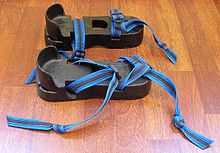Hojo undō
Hojo undō (補助運動) is a Japanese language term, translated as "supplementary exercises", that refers to the conditioning exercises specifically used in martial arts. Hojo undō training was designed to develop ambidextrous physical strength, stamina, muscle coordination, speed, and posture. This style of training uses simple, traditional devices, made from wood and stone.

Weighted items
Chi Ishi
Chi Ishi (weighted levers) are concrete weights that are attached to a wooden pole. The practitioner strongly grips to the end of the wooden pole (opposite the concrete weight), and moves his or her wrist and arms in motions used in techniques normally used in kata or against opponents. This weighted training helps strengthens the fingers, hands, arms, and chest.
Ishi sashi
Ishi sashi are hand-held weights in the shape of padlocks, traditionally made of stone.
Tetsu geta

Tetsu geta (iron clogs) are worn like sandals, but requires gripping the clogs with one's toes. The practitioner then moves around and kicks while wearing these. The extra weight required to move the foot strengthens the leg for kicks.
Nigiri game
Nigiri game (gripping jars) are ceramic jars filled with sand to different weights. The jars are gripped around a lipped rim. Then, while holding the jars, the practitioner moves in varying stances, in order to strengthen the arms, shoulders, back, and legs.
Makiage kigu
The makiage kigu (wrist roller) is a weight hanging by a rope from a wooden handle. The practitioner grasps the handle with the weight hanging in the middle, and twists the handle to wrap the rope around the handle. The handle is raised and lowered throughout the twisting to strengthen the wrists.
Tan
A "Tan" is similar to a modern barbell, made with a wood post and concrete weights on both ends.
Conditioning
Makiwara
The makiwara (striking board) is used to practice striking a target that provides resistance. There are two types of makiwara: sage-makiwara (hung from the ceiling) and the more common tachi-makiwara (secured in the ground). Of the tachi-makiwara, there are two variations: one flat and one round. The flat makiwara is created with a board placed into the ground and some type of padding on the top. The practitioner stands in front of the makiwara and strikes the top. The round ude-makiwara has a similar construction, but is round on all sides. This allows for additional techniques to be practiced.
Jari bako
The jari bako is a bowl filled with sand, smooth stones, or dry rice that is used by striking one's fingers into it. This conditions the fingers and fingertips.
Kongoken
The "Kongoken" is a metal bar formed into an oval that can vary in weight and is used to condition the arms, legs, strengthen the wrists and core. This was used by wrestlers in Hawaii, and adopted into the Hojo undō by Chogun Miyagi Sensei.
Tou
A "Tou" is simply a bundle of bamboo tied together either at both the top and bottom or tied in the middle. This is used similar to the Jari Bako by striking the fingers into it.